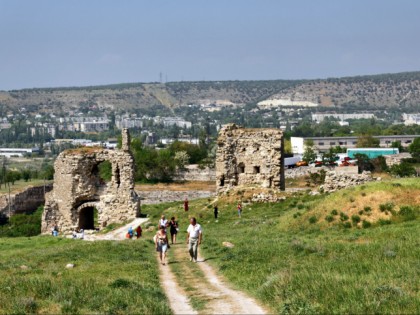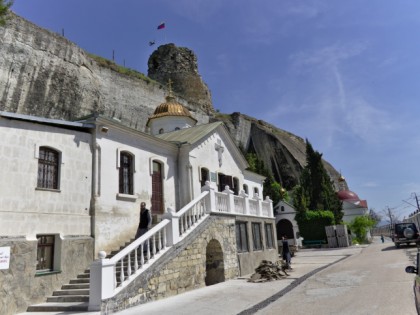Calamita Fortress and Inkerman St. Clement Cave Monastery
The Calamita Fortress and the Inkerman Monastery of St.Clement are built in the mountain on the right bank of the Chornaya River in the very depths of the Sevastopol Bay. According to a legend, the first cave church of Andrew the Apostle was carved into the rock by the St. Clement of Rome, exiled by the Roman Emperor Trajan in 98 to the Inkerman quarries for preaching Christianity. By the way, it is interesting that many structures in the Roman Empire were lined with Inkerman's stone.
Historians show that before Calamita Fortress the first buildings on the top of the mountain were occupied by the Byzantines in the VI century. In 1427 the Feodoro Prince Aleksey, who concluded an alliance with the Crimean khan and competed with the Genoese, built a new fortress on the old foundation. At the period of its prosperity Calamita was surrounded by a moat and a wall with five fortress towers 10-12 meters high. In 1475 the fortress fell. New owners the Ottomans started calling it Inkerman. By the XVII century Calamita was empty. Strong damage to the fortress was caused by the Second World War - only one fortress tower survived.
The monastery with three cave temples, including St. Clement monastery, was founded at the foot of the cliff in the VIII - IX centuries. It is considered to be one of the oldest cave monasteries in the Crimea! The monastery fell into decay with the Turks and was reborn again as the Inkerman St. Clement Cave Monastery after the annexation of the Crimea to Russia. In the following years the cave temples were restored and the ground churches of the Holy Trinity and the church of St. Panteleimon, destroyed in the Soviet era, were added to them. A new stage in the history of the monastery began in 1991 when monks began returning here. A particle of the relics of St. Clement, drowned by the order of Emperor Trajan in Chersonesus, is stored in the monastery today.








































